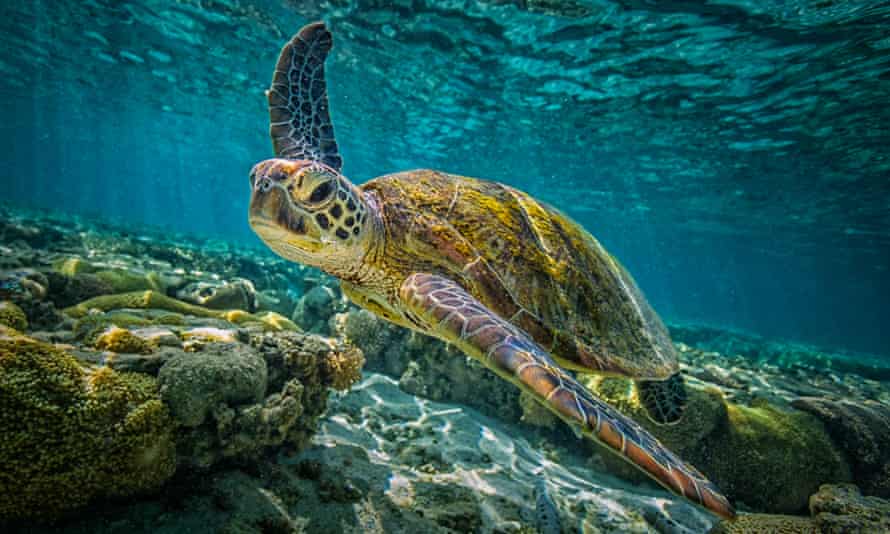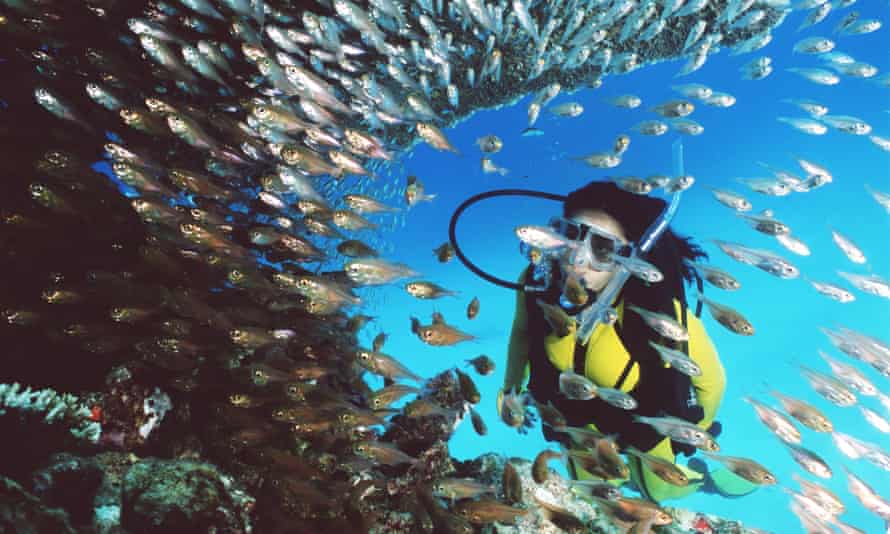Whether or not the Great Barrier Reef is listed as ‘in danger’ won’t alter the fact it is at risk from climate change
The Australian government pushed back fiercely against Unesco’s recommendation – and the world is watching

This year, Australia’s big tourism drawcard celebrates its 40th year as a UN world heritage site – a list where more than 1,100 of humanity’s most important spots go for acknowledgement and protection.
But on Friday, a committee of 21 countries will decide if it wants to listen to the advice of the UN’s science and culture organisation, Unesco, and put the Great Barrier Reef on its list of places that are “in danger”.
This is not the 40th anniversary party the reef’s legions of fans had hoped for – whether they’ve admired its 2,300km kaleidoscope of corals from a coffee table book or a mask and snorkel.
Because whatever happens at the meeting, there appears to be no scenario left where the threat of an “in danger” listing disappears for Australia.
And whatever the committee decides, experts and campaigners say the events of recent weeks will prove to be historic not only for the reef, but for the rest of the world’s natural wonders that could be jolted onto the list by climate change.
Ecosystems dominated by corals are predicted to be one of the first to collapse from global heating, caused by the world’s inability or unwillingness to cut its use of fossil fuels.
After Unesco made the call to the world heritage committee last month, the Australian government launched a frantic and forceful lobbying effort to keep the reef off the list.
Ambassadors from more than a dozen countries wearing fins and snorkel masks were dropped onto Agincourt Reef in the far north of Queensland, while environment minister Sussan Ley was dispatched on a diplomatic jet to Budapest, Madrid, Sarajevo, Paris, Oman and the Maldives.

A document that will be put before the committee on Friday evening suggests Australia may have gained enough support among its members to stave off the “in danger” listing until at least 2023.
A two-thirds majority of the committee is needed to put the reef on the list, but there could be last-minute movements. But Australia’s own amendments still leave in the text the “possible inscription” on the danger list in 2023.
The reef of the 70s
The reef was inscribed on the world heritage list in 1981, just three years after the very first natural sites – including the Galapagos Islands and Yellowstone National Park – were declared to have “outstanding universal value to humanity”.
The potted history of how the reef made the list starts with 1960s conservation campaigns to block limestone mining and oil drilling, leading to royal commissions and ultimately laws to create the Great Barrier Reef Marine Park Authority.
Richard Kenchington, now a professor at the Australian National Centre for Ocean Resources and Security at the University of Wollongong, was working at the authority in the late 70s when he was asked to coordinate the report that asked the world heritage committee to inscribe the reef.
Back then, the main worries for the reef, he says, were finding ways to control outbreaks of coral-eating starfish – a problem that continues today.
“Being one of the first nominations for the list just came from that growing global awareness of its significance. Here was a very large marine area that was being managed under legislation and that was seen globally as very exciting.”
He says the way the reef is managed is still rightly acknowledged as world-leading, but while many of the 3,000 or so individual reefs are still spectacular it will “never be the same as it was in the 1970s” before climate change took hold.

As well as the climate threat, Unesco says progress has been too slow in cutting pollution that runs into the reef from farms – primarily sugarcane and grazing properties.
The world heritage committee last discussed the reef in 2015, but since then there have been three mass bleaching events caused by rising ocean temperatures.
Scientists spoke of emerging from the water smelling of the dead and dying flesh of corals. The system’s ability to recover was being pushed to the brink.
“All of the world’s marine environments are endangered by climate change. Full stop,” says Kenchington.
Jewel in danger
Alongside the government’s aggressive response to the prospect of an “in danger” listing, Unesco’s recommendation sparked an exchange of letters between the prime minister, Scott Morrison, and the office of the Queensland premier, Annastacia Palaszczuk.
The letters reveal that on Wednesday Queensland rebuffed a request from Morrison to immediately sign off on a new version of the centrepiece joint reef policy.
In Paris, the Australian government’s ambassador to Unesco, Megan Anderson, had been sending a summary of the draft of that new policy to committee members.
Conservationists aware of the content say in its current form it does not go far enough to either improve water quality or lock in commitments for Australia to cut emissions in line with a rise in global temperatures to 1.5C – a level Unesco has asked for.
Anderson also sent committee members a draft of the Australian Institute of Marine Science’s latest annual monitoring report on the state of corals across the reef. She said it showed “widespread recovery was underway”.
The report also said the increase in coral coverage since the 2020 bleaching event was dominated by fast-growing species susceptible to storms and coral-eating starfish, and would be the first to go in the next bleaching event.
“The predicted consequences of climate change, which include more frequent and intense mass coral bleaching events, are now a contemporary reality,” the report said.
Protecting fossil fuels
Australia is a world-leading producer and exporter of coal and gas, and the country’s resources lobby is powerful. When the Guardian revealed oil-rich Saudi Arabia was backing Australia’s stance, there was a distinct lack of surprise in some quarters.
Prof Tiffany Morrison, of James Cook University, has been researching how countries and the UN deal with threats to world heritage sites.
In research published last year, she found when the world heritage committee gets asked to put places on the “in danger” list, it is resource-dependant countries that push back the hardest.
But why has Australia tried so hard?
Australia has made procedural arguments as it pushes back, saying Unesco should have first sent a monitoring mission (which, as the procedure dictates, Australia would need to formally request). Unesco says such a mission is not needed, especially when the evidence of the reef’s predicament is so clear.
But Prof Morrison believes there’s another unstated reason for Australia’s hardcore lobbying.
“If the reef goes on the ‘in danger’ list, the social licence for the government to approve more fossil fuel extraction falls over. This is not about tourism. This is about the social licence,” she says.
Australia’s lobbying effort, she says, has now set up a test of the world heritage committee’s integrity.
“This is pivotal. Do [the committee members] hold up the intentions of the convention [to protect the world’s heritage] or do they allow that to be undermined?”

She says Unesco has previously shied away from trying to address threats to sites that aren’t immediately local – with climate change being the most obvious “non-local” threat.
“But climate change is now affecting everything, and you can’t really ignore it anymore,” she says. “This is pivotal for the world heritage committee in that they begin to address climate change in a way that they have never done before.”
This lack of precedent, Prof Morrison says, is being used by Australia to say climate change should be left to the UN convention that delivered the Paris agreement.
Tourism at risk?
Daniel Gschwind is the chief executive of Queensland’s main tourism body, the Queensland Tourism Industry Council.
The degradation of parts of the reef, the bleaching events that create international headlines and how to engage with those issues as visitors step on boats is a challenge, Gschwind says. He says the reef is well managed and remains a spectacular experience for tourists.
“But we have to confront these things head-on and with a degree of honesty,” he says. “We owe it to ourselves to go with the science.
“The tourism operators are obviously not excited about the prospect of the reef being in the headlines for the wrong reasons. That’s not good news for us.
“But whatever way the decision goes, either now or in the future, I firmly believe this has to be our call to the world to do more on climate change. The reef is threatened and we need to do something about it.”
.png)
